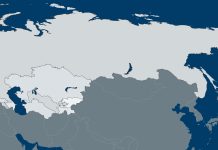By Kamran Bokhari
While the world is focused on the crises in the Middle East, the European Union, Russia and China, Central Asia – located at the center of these regions – is in meltdown. Central Asia cannot avoid being affected by the chaos in the countries surrounding it and is at risk of destabilization. The largest and wealthiest state in the region, Kazakhstan, is most at risk.
In recent weeks, Kazakhstan has been hit by two types of security challenges: civil unrest and terrorism. In May, Kazakh law enforcement agencies broke up demonstrations across the country, protesting plans to privatize large swathes of farmland.
The government of President Nursultan Nazarbayev and its ally, Russia, believe these protests were backed by the U.S. and designed to foment a color revolution. Considering the large area covered by the protests and the fact that this is an authoritarian state that does not tolerate any genuine opposition, the idea that the West was trying to push Kazakhstan into a Ukraine-like revolution is not unreasonable.
While Astana was still grappling with this issue, the country was rocked by a terrorist attack that killed 19 people on June 5. It was carried out by suspected Islamist militants in the northwestern industrial city of Aktobe. The attack, which involved 20 gunmen who struck at three separate locations, appears to have been a fairly sophisticated operation – at least for Kazakhstan, where such incidents are quite rare. Two cells struck at two separate firearms stores, while a third commandeered a bus and used it to ram the gate at a national guard base.
Nazarbayev, who is 76 years old and has ruled the oil-rich country for a quarter of a century, issued a statement warning that foreign forces were out to destabilize the country. Whether foreign actors played a role in either of the two incidents remains unclear. But it appears that both pro-democracy and jihadist forces are challenging the regime. For Geopolitical Futures, this is not surprising. Our forecast for the current year predicted that Central Asia is headed toward a crisis.
Our position has been that the Central Asian states will destabilize because the world around them has descended into turmoil. The Middle East is in chaos because of the meltdown of autocratic regimes, which has enabled the Islamic State to emerge as a major international security threat. The European Union has become an incoherent entity and faces an uncertain future as Germany deals with a looming export crisis. To the east, China’s growth miracle has come to an end. Finally, Russia, which wields the most influence in Central Asia, is in deep trouble because of the plunge in oil prices.
Therefore, it is impossible for Central Asia to remain an island of stability in the middle of an ocean of chaos. Though we are at the beginning of the unraveling, the events in Kazakhstan show that our forecast is on track. For over two decades, the country’s leadership has maintained stability largely because of revenues from crude oil exports. It was a country built on oil wealth, with Western and Chinese investor interest and a strong alliance with Russia.
With the steep decline in oil prices, the Nazarbayev regime is struggling to maintain order. Nazarbayev and his top associates have been trying to deal with rampant corruption in the armed forces. The impending leadership transition (due to Nazarbayev’s age) and the weakening of the authoritarian system are creating space for a host of actors who until now were kept at bay.
It will be a while before the instability metastasizes in Kazakhstan, and at this early stage it is difficult to know how events will unfold. However, there are few arrestors in the path of this trajectory. Those forces seeking democratic change seem weak, while those with an Islamist agenda in this Muslim-majority nation seem more powerful – in no small part due to their use of armed insurrection. Therefore, the country may turn into a large ungoverned space while the world continues to hope democrats will replace the Soviet-era regime.
This is similar to the Arab Spring, which the West hoped would bring democracy to the Arab world; this hope soon faded. The Arab Spring started in a relatively small North African country, Tunisia, but then quickly spread across the Middle East. In Central Asia, the instability has started in the largest country in the region – leaving other Central Asian states vulnerable. When Kazakhstan destabilizes, Turkmenistan, Uzbekistan, Tajikistan and even Kyrgyzstan (which has already gone through one popular uprising) will not be far behind.
All these states, along with Russia, have long been worried about how post-NATO Afghanistan could destabilize Central Asia and even Russia. However, the biggest state in the north of the region, far from Afghanistan, is actually where the unrest has begun.
The geopolitical precipice that Central Asia is now standing on – highlighted by the events in Kazakhstan – suggests that the fallout from a resurgent Taliban in Afghanistan may be just a footnote in the story of how this region foundered.








